Alco "RS1" Locomotives: Roster, Specs, Data Sheet
Last revised: December 27, 2024
By: Adam Burns
The American Locomotive Company (Alco) could seemingly never outdo the Electro-Motive Division for dominance in the early diesel locomotive market.
Despite this, the company would develop one of the most important layouts for how all future diesel locomotives would be built; the RS1, which pioneered the original road-switcher design.
Not only would EMD go on to use the carbody style in its later General Purpose (GP) series but also the offset cab layout is still used today by General Electric and successor Electro-Motive Diesel.
The RS1 was in production longer than any other model at the time, remaining in Alco's catalog for nearly 20 years. Today, you can still find a handful of these rugged workhorses preserved at various museums around the country - some of which are even still operational.
Photos
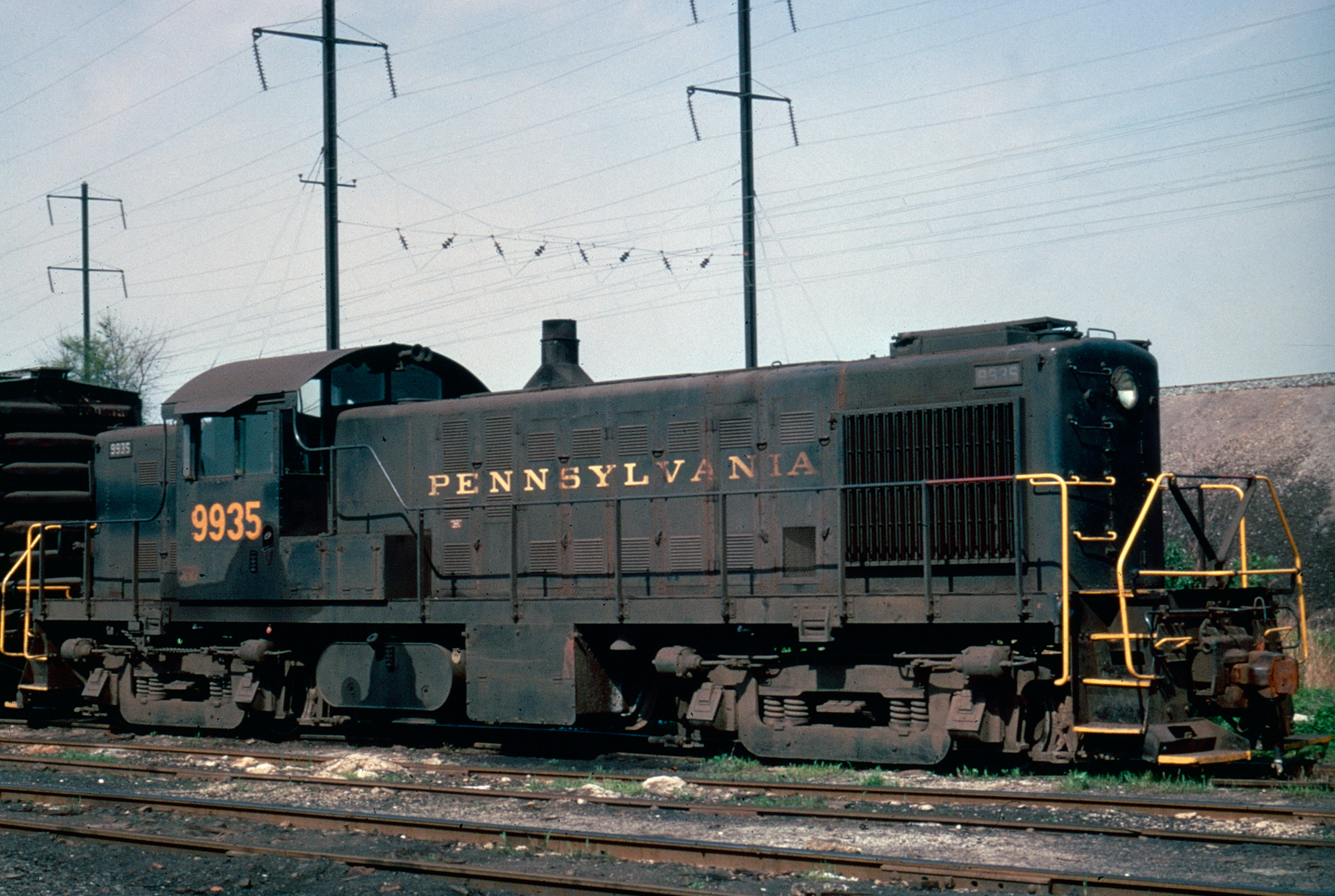 It's the early Penn Central era as a former Pennsylvania RS-1 lays over in Bristol, Pennsylvania along the Northeast Corridor during the spring of 1968. Photographer unknown. American-Rails.com collection.
It's the early Penn Central era as a former Pennsylvania RS-1 lays over in Bristol, Pennsylvania along the Northeast Corridor during the spring of 1968. Photographer unknown. American-Rails.com collection.The RS1 was released by the builder in early 1941; it was the first in a long line of Road Switcher models that ended in 1963 with the RS36. It is also recognized as the first, true road-switcher ever cataloged by a locomotive manufacturer. Alco's history with its early, cataloged diesel switchers dated all of the way back to its demonstrator HH300 models (High Hood) of the early 1930s.
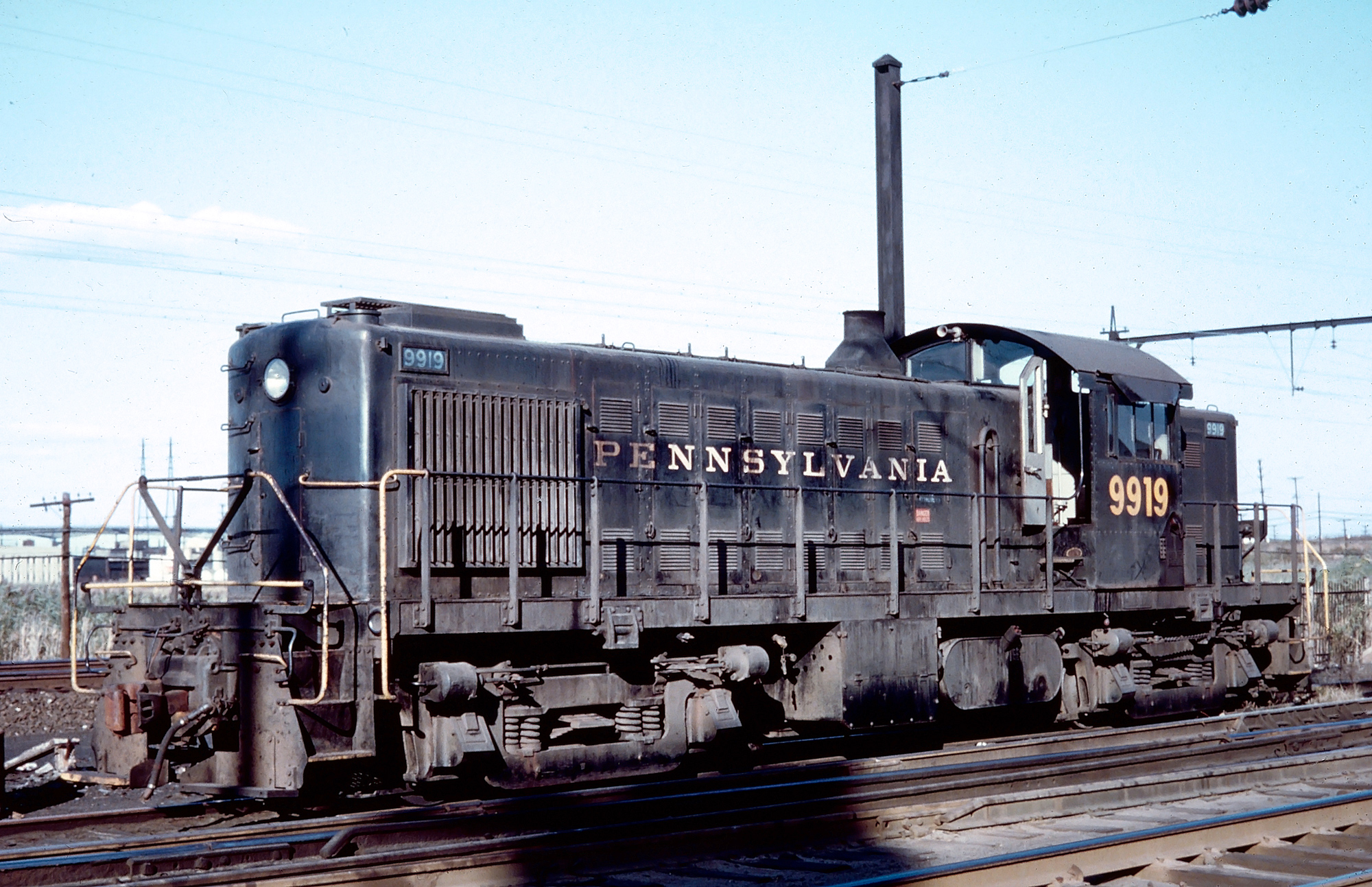 Pennsylvania RS1 #9919 at Meadows Yard in Kearny, New Jersey, circa 1967. Fred Byerly photo. American-Rails.com collection.
Pennsylvania RS1 #9919 at Meadows Yard in Kearny, New Jersey, circa 1967. Fred Byerly photo. American-Rails.com collection.However, the company's history with diesel locomotive technology goes back even further to a testbed switcher outshopped in July, 1925 in conjunction with General Electric and Ingersoll-Rand. In his book, "The Diesel Builders, Volume Two: American Locomotive Company and Montreal Locomotive Works," author John Kirkland notes this 300 horsepower, 60-ton unit was completed as Alco order S1484, construction number 65979.
The early "HH" series models were essentially prototypes themselves, built in conjunction with Westinghouse and McIntosh & Seymore, and sold to a handful of railroads. Interestingly, as Kirkland points out, Alco never actually cataloged these switchers as "High Hood," designs. This was yet another term later coined by railfans.
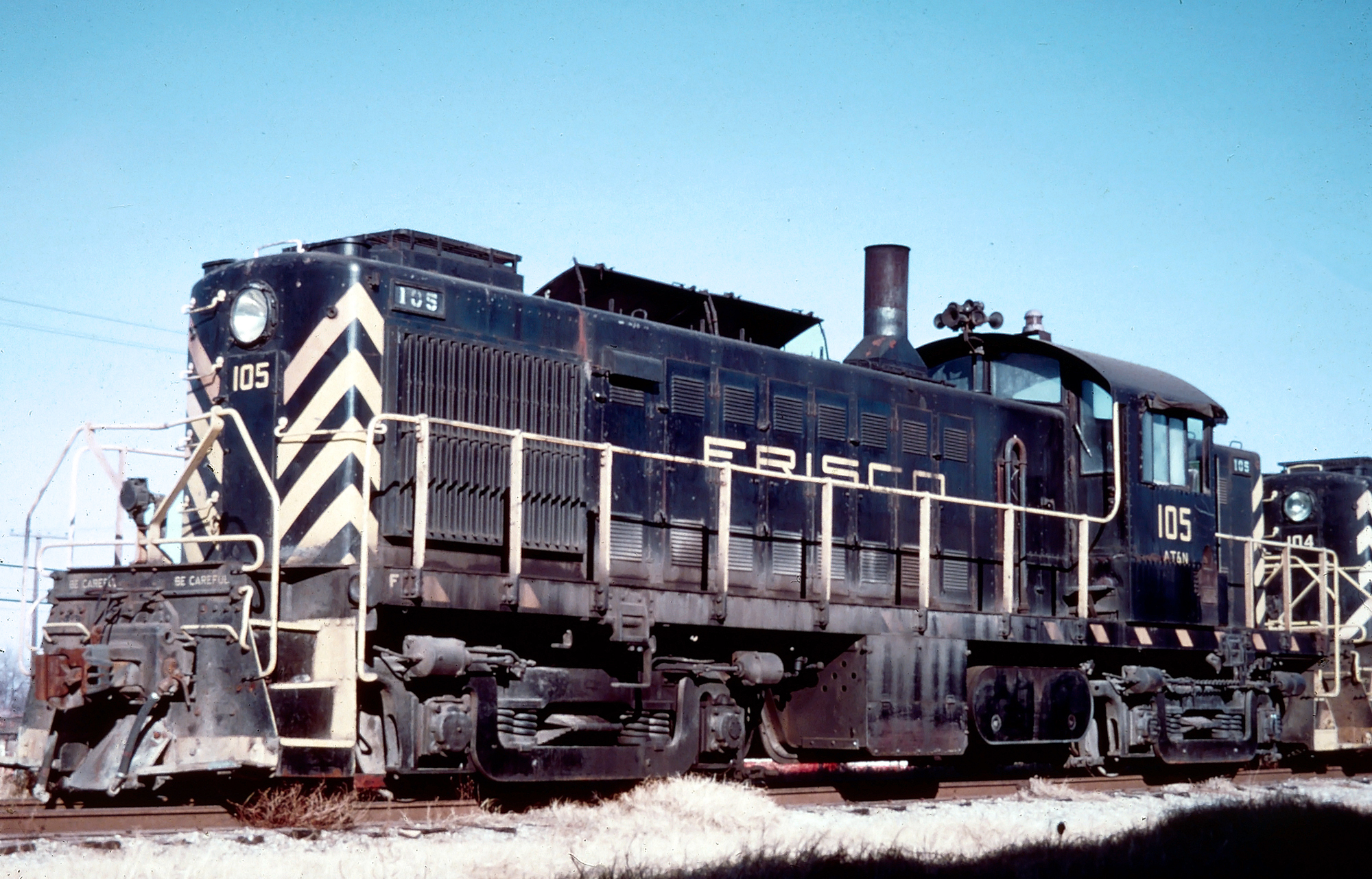 St. Louis-San Francisco Railway RS-1 #105, sub-lettered for subsidiary Alabama, Tennessee & Northern, is seen here in Springfield, Missouri, circa 1965. Mac Owen photo. American-Rails.com collection.
St. Louis-San Francisco Railway RS-1 #105, sub-lettered for subsidiary Alabama, Tennessee & Northern, is seen here in Springfield, Missouri, circa 1965. Mac Owen photo. American-Rails.com collection.The RS1, a design requested at the behest of Rock Island's chief operating officer, J.D. Farrington for use in passenger service along its lightly populated branch lines in the Midwest. In addition to passenger assignments consisting of only one or two cars, railroads soon found the RS1 could handle both light freight duties and switching assignments.
The RS1 was given slight design features from famed industrial designer Otto Kuhler. Most noteworthy is that they were the first to employ raised cabs for better visibility, so commonly employed in today's locomotives. Designed by Westinghouse as the "visibility cab", they were normally wider and taller than the engine hood providing crews with better visibility featuring an arched roof line.
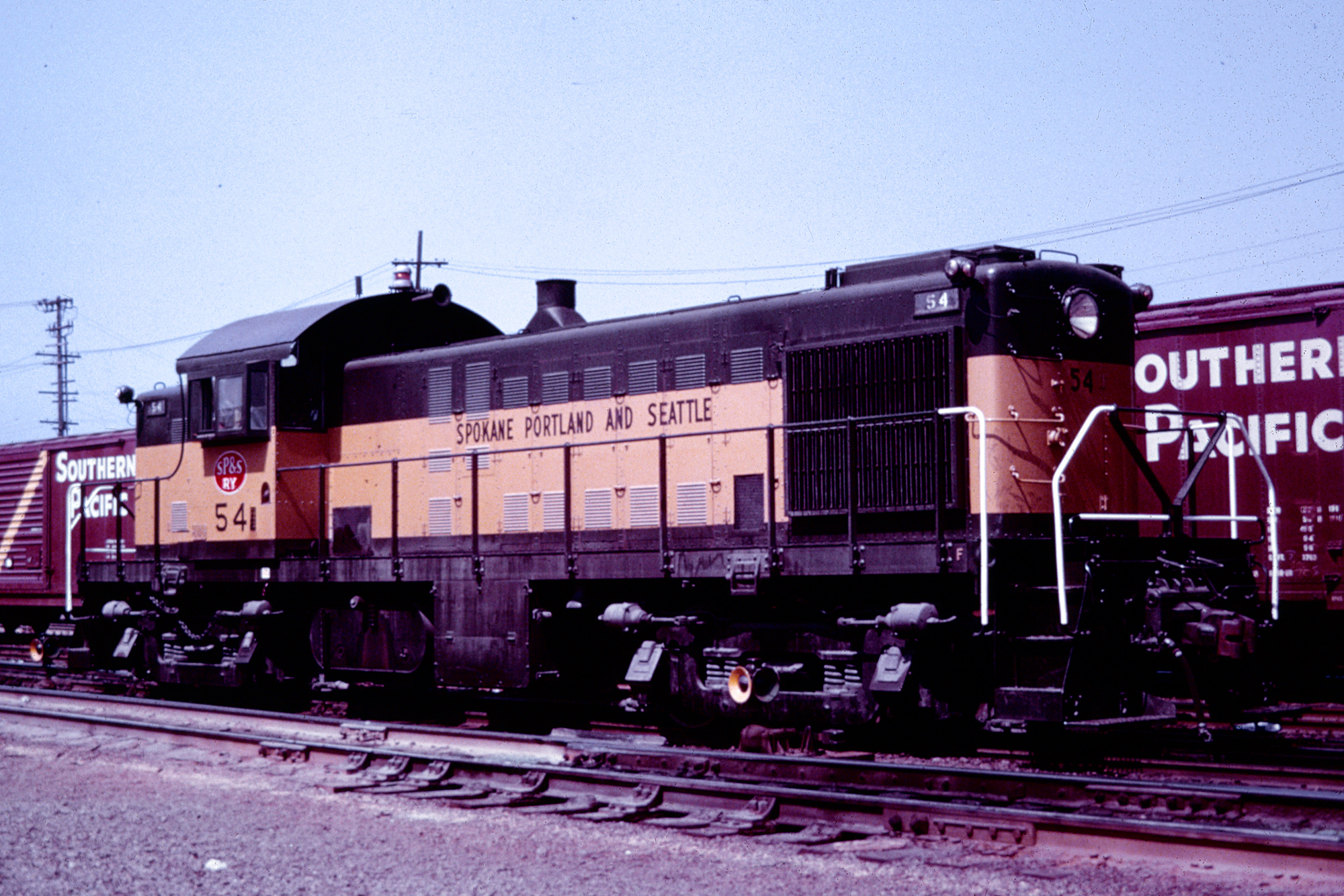 Spokane, Portland & Seattle RS1 #54 at Portland, Oregon; August, 1965. Fred Byerly photo. American-Rails.com collection.
Spokane, Portland & Seattle RS1 #54 at Portland, Oregon; August, 1965. Fred Byerly photo. American-Rails.com collection.As such, it featured a long hood to house the 539T power plant, a McIntosh & Seymore with a cab was placed offset on the frame. This setup gave the locomotive a short hood at one end, used to house a steam generator for passenger service.
Data Sheet and Specifications
1941-1942
| Alco Class | 404-DL-240 |
| Entered Production | 3/14/1941 |
| Years Produced | 3/1941-6/1942 |
| Model Specification | E1640 |
| Engine | 539T, 6-Cylinder In-Line, Turbocharged |
| Engine Builder | Alco/McIntosh & Seymour |
| Horsepower | 1,000 |
| Carbody Styling | Alco |
| Length (Between Coupler Faces) | 55' 11 ¾" |
| Height (Top of Rail to Top of Cab) | 14' 6" |
| Width | 10' 0" |
| Weight | 240,000 Lbs |
| Dynamic Brakes | Yes |
| Air Brake Schedule | 14EL |
| Trucks | B-B |
| Truck Type | Swing Bolster, Drop-Side Equalizer (AAR Type-B) |
| Wheelbase | 9' 4" |
| Wheel Size | 40" |
| Traction Motors | GE 731 (4) |
| Traction Generator | GT533 |
| Gear Ratio | 75:16 |
| Tractive Effort Rating (Starting) | 72,000 Lbs (at 30% adhesion) |
| Tractive Effort Rating | 34,000 Lbs at 8 MPH |
| Top Speed | 60 MPH |
Post World War II
| Alco Class | 404-DL-240 |
| Entered Production | 3/14/1941 |
| Years Produced | 1945-11/1957 |
| Model Specification | E1641/A |
| Engine | 539T, 6-Cylinder In-Line, Turbocharged |
| Engine Builder | Alco/McIntosh & Seymour |
| Horsepower | 1,000 |
| Carbody Styling | Alco |
| Length (Between Coupler Faces) | 55' 11 ¾" |
| Height (Top of Rail to Top of Cab) | 14' 6" |
| Width | 10' 0" |
| Weight | 240,000 Lbs |
| Dynamic Brakes | Yes (Optional) |
| Air Brake Schedule | 14EL |
| Trucks | B-B |
| Truck Type | Swing Bolster, Drop-Side Equalizer (AAR Type-B) |
| Wheelbase | 9' 4" |
| Wheel Size | 40" |
| Traction Motors | GE 731D (4) |
| Traction Generator | GT553A |
| Gear Ratio | 75:16 |
| Tractive Effort Rating (Starting) | 72,000 Lbs (at 30% adhesion) |
| Tractive Effort Rating (Continuous) | 34,000 Lbs at 8 MPH |
| Top Speed | 60 MPH |
Prior to the start of World War II there were thirteen RS1's produced for five different railroads. Please refer to the table below. These locomotives were later requisitioned by the U.S. Army for use on the Trans-Iranian Railway to supply Russia with war materiel during the conflict.
The locomotives were based out of the Port of Bandar Shahpur on the Persian Gulf, running 685 miles largely through an arid, desert environment before entering elevations of 7,000 feet.
The Army had Alco retrofit the units with tapered cabs and change the roof line to meet tunnel clearances. In addition, the B-B, four-axle trucks were swapped out for C-C, six-axle trucks (all-powered). These were essentially the first "RSD-1" models.
New locomotives were later built for the original railroads (paid by the U.S. government) to replace those requisitioned, in April and May of 1943 (1946 for the Tennessee Coal, Iron & Railroad).
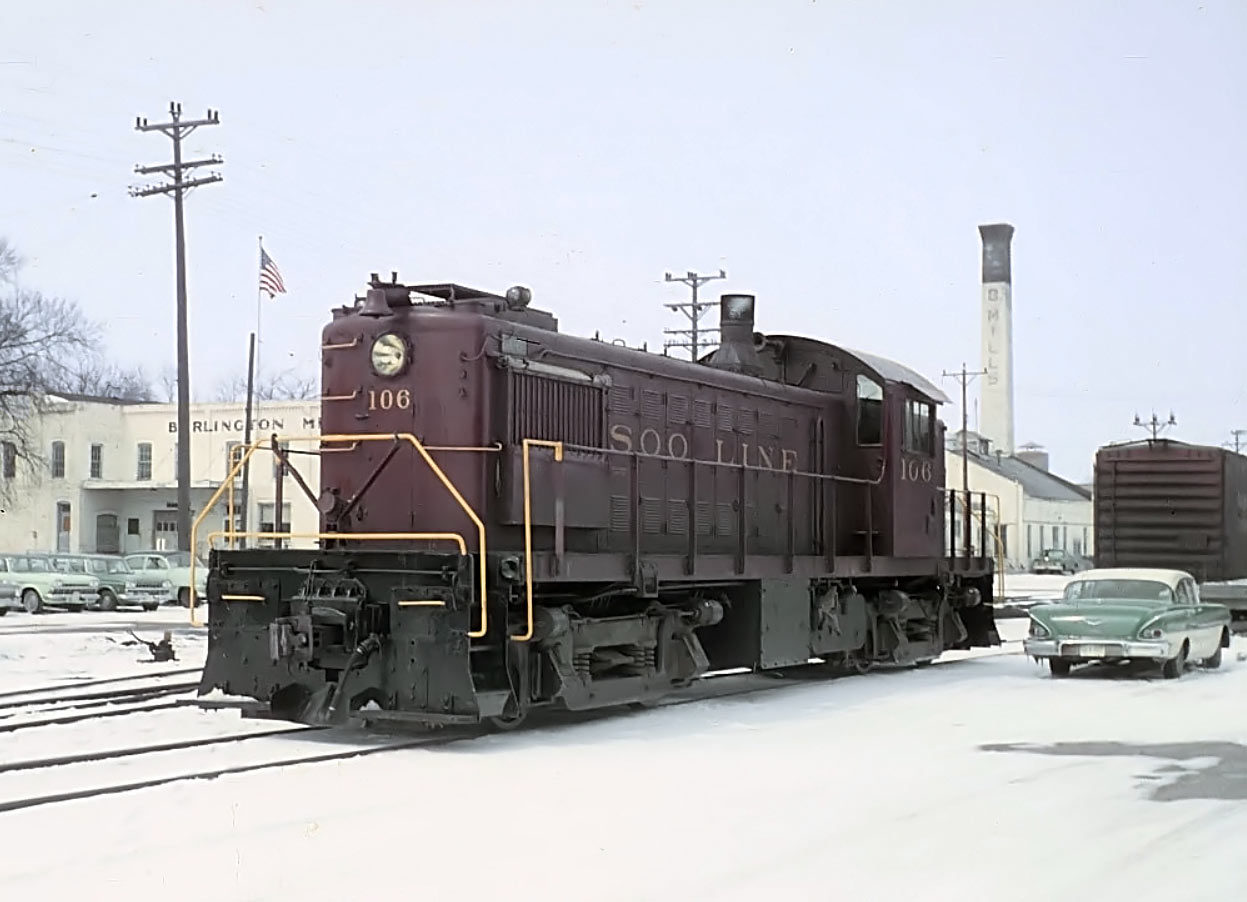 One of the Soo Line's rugged RS1s, #106 (built as Duluth, South Shore & Atlantic #106), is tied down at Burlington, Wisconsin in April, 1964. Rick Burn photo.
One of the Soo Line's rugged RS1s, #106 (built as Duluth, South Shore & Atlantic #106), is tied down at Burlington, Wisconsin in April, 1964. Rick Burn photo.Production Rosters
Pre-War Production Board (WPB) Units
These RS1s were completed before the War Production Board (WPB) took control of manufacturing throughout the nation and imposed restrictions on new diesels produced. This went into effect on April 4, 1942.
Total Built = 13
| Railroad | Road Number | Construction Number | Date Built | Date Rebuilt (Army) | U.S. War Department Number | Replacement Construction Number (RR) | Date Rebuilt For Railroads | New Road Number |
|---|---|---|---|---|---|---|---|---|
| Rock Island | 748 | 69424 | 3/1941 | 11/1942 | 8005 | 70816 | 5/1943 | 742 |
| Rock Island | 749 | 69425 | 3/1941 | 12/1942 | 8006 | 70817 | 5/1943 | 743 |
| Atlanta & St. Andrews Bay | 901 | 69426 | 3/1941 | 1/1943 | 8010 | 70810 | 4/1943 | 904 |
| Atlanta & St. Andrews Bay | 902 | 69427 | 3/1941 | 1/1943 | 8011 | 70811 | 4/1943 | 904 |
| Tennessee Coal, Iron & Railroad | 600 | 69428 | 4/1941 | 12/1942 | 8008 | 75203 | 10/1946 | 602 |
| Tennessee Coal, Iron & Railroad | 601 | 69566 | 4/1941 | 1/1943 | 8009 | 75204 | 10/1946 | 603 |
| Milwaukee Road | 1678 | 69567 | 6/1941 | 11/1942 | 8002 | 70814 | 4/1943 | 1676 |
| Milwaukee Road | 1679 | 69568 | 6/1941 | 11/1942 | 8003 | 70815 | 4/1943 | 1677 |
| Rock Island | 746 | 69569 | 8/1941 | 12/1942 | 8007 | 70818 | 5/1943 | 744 |
| Rock Island | 747 | 69570 | 8/1941 | 11/1942 | 8004 | 70819 | 5/1943 | 745 |
| Atlanta & St. Andrews Bay | 903 | 69800 | 6/1942 | 1/1943 | 8012 | 70821 | 4/1943 | 906 |
| New York, Susquehanna & Western | 231 | 69992 | 6/1942 | 11/1942 | 8000 | 70812 | 4/1943 | 231 |
| New York, Susquehanna & Western | 233 | 69993 | 6/1942 | 11/1942 | 8001 | 70813 | 4/1943 | 233 |
The six-axle version came in either a C-C or A1A-A1A truck setup. The standard RS1 came in a B-B truck setup (four axles) and could produce 34,000 pounds of tractive effort with a top speed of 60 mph (although it rarely ever reached such speeds). It was quite short at just 54 feet, 11 inches and also featured a very low profile.
Overall, the model weighed just 120 tons and featured electrical and other components from both General Electric and Westinghouse. With the Rock Island's original request it was one of the initial railroads to receive the model when the first batches were completed in March of 1941, delivered to:
- Tennessee Coal & Iron
- Milwaukee Road
- New York, Susquehanna & Western
- Atlanta & St. Andrews Bay Railroad
Post World War II
Total Built = 340
| Owner | Road Number(s) | Construction Number(s) | Completion Date |
|---|---|---|---|
| Akron, Canton & Youngstown | D-2 | 74323 | 10/1945 |
| Alabama, Tennessee & Northern | 101, 102 | 71435, 73096 | 11/1944, 12/1944 |
| Alabama, Tennessee & Northern | 103, 104 | 73326, 73327 | 3/1945 |
| Alabama, Tennessee & Northern | 105, 106 | 73758, 74321 | 6/1945, 10/1945 |
| Alabama, Tennessee & Northern | 107-109 | 75110-75112 | 5/1946 - 6/1946 |
| Alabama, Tennessee & Northern | 110, 111 | 75480, 75481 | 8/1947 |
| Alaska Railroad | 1000, 1001 | 71319, 71320 | 5/1944 |
| Alton Railroad | 50 | 74322 | 10/1945 |
| Alton Railroad | 51-53 | 74494-74496 | 11/1945 |
| Alton Railroad | 54-58 | 74677-74681 | 11/1945 |
| Alton Railroad | 59 | 74823 | 12/1945 |
| Ann Arbor | 20, 21 | 78374, 78375 | 11/1950 |
| Santa Fe | 2385-2387 | 75391-75393 | 6/1947 - 7/1947 |
| Santa Fe | 2388 | 75482 | 8/1947 |
| Santa Fe | 2394, 2395 | 78115, 77838 | 8/1950, 12/1949 |
| Atlanta & St. Andrews Bay | 904, 905 | 70810, 70811 | 4/1943 |
| Atlanta & St. Andrews Bay | 906 | 70821 | 4/1943 |
| Atlanta & St. Andrews Bay | 907, 908 | 70809, 70822 | 11/1943 |
| Atlanta & St. Andrews Bay | 909 | 72812 | 6/1944 |
| Atlanta & St. Andrews Bay | 910, 911 | 73332, 73333 | 4/1945 |
| Atlanta & St. Andrews Bay | 912, 913 | 75559, 77848 | 10/1947, 2/1950 |
| Atlantic & East Carolina | 500 | 79047 | 4/1951 |
| Bamberger Railroad | 570 | 70820 | 5/1943 |
| Central Railroad of New Jersey | 1200-1204 | 78095-78099 | 6/1950 |
| Central Railroad of New Jersey | 1205 | 79234 | 9/1951 |
| Chesapeake & Ohio | 5114, 5115 | 80851, 80852 | 9/1953 |
| Chicago & Eastern Illinois | 115-118 | 73328-73331 | 4/1945 |
| Chicago & North Western | 1066 | 79589 | 9/1953 |
| Chicago & North Western | 1067, 1068 | 79590, 79591 | 8/1953 |
| Chicago & North Western | 1069 | 80850 | 9/1953 |
| Chicago & North Western | 1080 | 72816 | 8/1944 |
| Chicago & North Western | 1081 (1st) | 72921 | 9/1944 |
| Chicago & Western Indiana | 252, 253 | 76799, 76800 | 7/1949 |
| Chicago & Western Indiana | 254-257 | 77172-77175 | 10/1949 - 11/1949 |
| Chicago & Western Indiana | 258, 259 | 77836, 77837 | 12/1949 |
| Chicago & Western Indiana | 260-263 | 77849-77852 | 2/1950 |
| Milwaukee Road | 961-963 | 77469-77471 | 3/1950 |
| Milwaukee Road | 1676, 1677 | 70814, 70815 | 4/1943 |
| Rock Island | 735-739 | 71312-71316 | 1/1944 - 2/1944 |
| Rock Island | 740, 741 | 70823, 70824 | 11/1943 |
| Rock Island | 742-745 | 70816-70819 | 5/1943 |
| Duluth, South Shore & Atlantic (Soo Line) | 100, 101 | 73753, 73760 | 5/1945, 6/1945 |
| Duluth, South Shore & Atlantic (Soo Line) | 102 | 75215 | 12/1946 |
| Duluth, South Shore & Atlantic (Soo Line) | 103-105 | 75217-75219 | 1-2/1947 |
| Duluth, South Shore & Atlantic (Soo Line) | 106, 107 | 75389, 78376 | 5/1947, 1/1951 |
| DuPont | 105-108 | 79050-79053 | 6-7/1951 |
| Gaylord Container | 302, 303 | 75842, 75843 | 5/1948 |
| GE-Atomic Energy Commission | 39-3729, 39-3730 | 75844, 76206 | 6/1948 |
| GE-Atomic Energy Commission | 39-3731, 39-3732 | 76210, 76211 | 10/1948 |
| Genesee & Wyoming | 25, 30 | 79580, 81345 | 1/1952, 5/1955 |
| Grand Trunk Western | 1950, 1951 | 82355, 82356 | 11/1957 |
| Great Northern | 182, 183 | 72922, 72923 | 9/1944 |
| Great Northern | 184, 185 | 72924, 71433 | 11/1944, 10/1944 |
| Gulf, Mobile & Ohio | 1102 | 71438 | 11/1944 |
| Gulf, Mobile & Ohio | 1103, 1104 | 73094, 73095 | 12/1944 |
| Gulf, Mobile & Ohio | 1105-1107 | 73335-73337 | 4/1945 |
| Gulf, Mobile & Ohio | 1108, 1109 | 73573, 73574 | 5/1945 |
| Gulf, Mobile & Ohio | 1110 | 73752 | 5/1945 |
| Gulf, Mobile & Ohio | 1111, 1112 | 74910, 74911 | 1/1946, 4/1946 |
| Gulf, Mobile & Ohio | 1113 | 75216 | 1/1947 |
| Gulf, Mobile & Ohio | 1114, 1115 | 75220, 75221 | 2/1947 |
| Gulf, Mobile & Ohio | 1116, 1117 | 75223, 75224 | 3/1947 |
| Gulf, Mobile & Ohio | 1120 | 76219 | 12/1948 |
| Gulf, Mobile & Ohio | 1121, 1122 | 76624, 76625 | 1/1949 |
| Gulf, Mobile & Ohio | 1123-1125 | 76629-76631 | 3/1949 - 4/1949 |
| Gulf, Mobile & Ohio | 1126, 1127 | 76796, 76798 | 4/1949, 5/1949 |
| Illinois Terminal | 750-752 | 75839-75841 | 5/1948 |
| Illinois Terminal | 754 | 77855 | 3/1950 |
| Illinois Terminal | 755, 756 | 77069, 77070 | 3/1950 |
| Kansas City Southern | 1110-1113 | 70825-70828 | 11/1943 - 12/1943 |
| Lake Erie, Franklin & Clarion | 20, 21 | 76797, 78241 | 4/1949, 8/1950 |
| Lake Superior & Ishpeming | 1001-1003 | 79576-79578 | 11/1951 - 12/1951 |
| Long Island Railroad | 461, 462 | 76220, 76622 | 12/1948, 1/1949 |
| Long Island Railroad | 463-465 | 76626-76628 | 2/1949 - 3/1949 |
| Long Island Railroad | 466-469 | 77475-77478 | 4/1950 |
| Midland Continental Railroad | 401, 402 | 74912, 79579 | 4/1946, 12/1951 |
| Minneapolis & St. Louis | 244 | 71317 | 2/1944 |
| Minneapolis & St. Louis | 744, 944 | 71434, 71436 | 7/1944, 9/1944 |
| Minneapolis & St. Louis | 1044, 1144 | 73093, 79097 | 10/1944, 11/1944 |
| Minneapolis & St. Louis | 645, 745 | 73334, 73759 | 6/1945, 7/1945 |
| Minneapolis & St. Louis | 845, 945 | 74317, 74318 | 8/1945, 9/1945 |
| Minneapolis &a St. Louis | 146, 246 | 74821, 74822 | 1/1946, 2/1946 |
| Minneapolis & St. Louis | 346, 446 | 74824, 74909 | 3/1946, 4/1946 |
| Minneapolis & St. Louis | 546, 646 | 75113, 75114 | 5/1946, 6/1946 |
| Minneapolis & St. Louis | 746, 846 | 75115, 75116 | 7/1946, 8/1946 |
| Minneapolis & St. Louis | 946, 1046 | 75117, 75118 | 9/1946, 10/1946 |
| Minneapolis & St. Louis | 547 | 75390 | 5/1947 |
| Minneapolis & St. Louis | 948, 1048 | 76207, 76208 | 9/1948, 10/1948 |
| Minneapolis & St. Louis | 1148 | 76209 | 11/1948 |
| Minneapolis & St. Louis | 849, 949 | 77842, 77843 | 8/1949, 9/1949 |
| Minneapolis & St. Louis | 1049, 1149 | 77844, 77845 | 10/1949, 11/1949 |
| Minneapolis & St. Louis | 1249 | 77846 | 12/1959 |
| Minneapolis & St. Louis | 950, 1050 | 78243, 78244 | 9/1950, 10/1950 |
| Minneapolis & St. Louis | 1150, 1250 | 78245, 78373 | 11/1950, 12/1950 |
| Minneapolis & St. Louis | 751 | 79235 | 7/1951 |
| Minneapolis & St. Louis | 851, 951 | 79346, 79347 | 8/1951, 9/1951 |
| Minneapolis, St. Paul & Sault Ste Marie (Soo Line) | 350, 351 | 80853, 80854 | 12/1954 |
| Minneapolis, St. Paul & Sault Ste Marie (Soo Line) | 352, 353 | 80978, 80979 | 12/1954 |
| New York Central | 8100 | 75825 | 2/1948 |
| New York Central | 8101-8105 | 75680-75684 | 1/1948 - 2/1948 |
| New York Central | 8106-8108 | 75826-75828 | 2/1948 - 3/1948 |
| New York Central | 8109-8111 | 77986-77988 | 4/1950 |
| New York Central | 8112, 8113 | 78090, 78091 | 5/1950 |
| New Haven | 0660-0669 | 75829-75838 | 3/1948 - 4/1948 |
| New Haven | 0670, 0671 | 76212, 76213 | 11/1948 |
| New York, Susquehanna & Western | 230 | 71437 | 11/1944 |
| New York, Susquehanna & Western | 231, 233 (2nd) | 70812, 70813 | 4/1943 |
| New York, Susquehanna & Western | 232-236 (Evens) | 73098-73100 | 1/1945 |
| New York, Susquehanna & Western | 238, 240 | 73568, 73569 | 4/1945 |
| New York, Susquehanna & Western | 242, 244 | 73754, 73755 | 5/1945 |
| New York, Susquehanna & Western | 246-252 (Evens) | 75555-75558 | 9/1947 - 10/1947 |
| New York, Susquehanna & Western | 254, 256 | 79584, 79585 | 6/1953 |
| Northern Pacific | 155 | 73761 | 6/1945 |
| Northern Pacific | 156 | 74316 | 10/1945 |
| Northern Pacific | 157, 158 | 73765, 73766 | 8/1945 |
| Oregon Electric Railway | 52-54 | 73570-73572 | 4/1945 - 5/1945 |
| Oregon Electric Railway | 55 | 73756 | 6/1945 |
| Pennsylvania Railroad | 5619, 5620 | 78106, 78107 | 6/1950 |
| Pennsylvania Railroad | 5621-5624 | 78110-78113 | 6/1950 - 7/1950 |
| Pennsylvania Railroad | 5625-5628 | 78100-78103 | 6/1950 |
| Pennsylvania Railroad | 5629 | 78114 | 8/1950 |
| Pennsylvania Railroad | 5630, 5631 | 78116, 78117 | 8/1950 |
| Pennsylvania Railroad | 5632-5636 | 78159-78163 | 8/1950 |
| Pennsylvania Railroad | 5637, 5638 | 78104, 78105 | 6/1950 |
| Pennsylvania Railroad | 5639, 5640 | 78108, 78109 | 6/1950 |
| Pennsylvania Railroad | 5906 | 76214 | 12/1948 |
| Pennsylvania Railroad | 8485, 8486 | 79582, 79583 | 5/1952 |
| Pennsylvania Railroad | 8857, 8858 | 78377, 79046 | 4/1951 |
| Rutland Railway | 400, 401 | 79349, 79350 | 10/1951 |
| Rutland Railway | 402-405 | 79572-79575 | 10/1951 - 11/1951 |
| Spokane International | 200-205 | 77166-77171 | 9/1949 - 10/1949 |
| Spokane International | 206-208 | 77839-77841 | 12/1949 |
| Spokane International | 209-211 | 79586-79588 | 7/1953 - 8/1953 |
| Spokane, Portland & Seattle | 50, 51 | 73757, 73762 | 6/1945, 7/1945 |
| Tennessee Coal & Iron | 602, 603 | 75203, 75204 | 10/1946 |
| Tennessee Coal & Iron | 604 | 75484 | 9/1947 |
| U.S. Navy | 6 | 72817 | 9/1944 |
| Washington Terminal | 40 | 71318 | 3/1944 |
| Washington Terminal | 41-43 | 72813-72815 | 6/1944 - 7/1944 |
| Washington Terminal | 44, 45 | 73763, 73764 | 7/1945, 8/1945 |
| Washington Terminal | 46, 47 | 74314, 74315 | 9/1945 |
| Washington Terminal | 48, 49 | 74319, 74320 | 10/1945 |
| Washington Terminal | 50-54 | 75560-75564 | 11/1947 - 12/1947 |
| Washington Terminal | 55 | 75679 | 12/1947 |
| Washington Terminal | 56-59 | 76215-76218 | 12/1948 |
| Washington Terminal | 60-62 | 77472-77474 | 3/1950 |
| Washington Terminal | 63, 64 | 79048, 79049 | 5/1951 |
| Wisconsin Central (Soo Line) | 2360, 2361 | 77853, 77854 | 2/1950, 3/1950 |
| Wisconsin Central (Soo Line) | 2362 | 78242 | 8/1950 |
| Wisconsin Central (Soo Line) | 2363, 2364 | 79054, 79055 | 8/1951 |
| Wisconsin Central (Soo Line) | 2365-2367 | 79231-79233 | 9/1951 |
| Wisconsin Central (Soo Line) | 2368 | 79581 | 3/1952 |
Export
Total Built = 116
| Owner | Road Number(s) | Construction Number(s) | Completion Date |
|---|---|---|---|
| Arabian-American Oil Company (Saudi Arabia) | A11x50, A11x51 | 75222, 75488 | 2/1947, 9/1947 |
| Arabian-American Oil Company (Saudi Arabia) | 1002 | 76623 | 1/1949 |
| Arabian-American Oil Company (Saudi Arabia) | 1003, 1004 | 77071, 77072 | 3/1950 |
| Arabian-American Oil Company (Saudi Arabia) | 1005 | 79348 | 10/1951 |
| Central Railway of Brazil | 3100-3119 | 71413-71432 | 4/1945 - 10/1945 |
| Central Railway of Brazil | 3120-3133 | 73703-73716 | 10/1945 - 1/1946 |
| Central Railway of Brazil | 3134, 3135 | 75924, 75925 | 7/1948 |
| Central Railway of Brazil | 3136, 3137 | 75930, 75931 | 8/1948, 9/1948 |
| São Paulo Railway (Brazil) | 504-507 | 75926-75929 | 8/1948 |
| São Paulo Railway (Brazil) | 508, 509 | 75932, 75933 | 9/1948 |
| Estrada de Ferro Santos-Jundiaí (Brazil) | 510, 511 | 81346, 82018 | 4/1956, 12/1956 |
| Ferrocarriles Nacionales de México (Mexico) | 5606, 5607 | 77847, 77073 | 2/1950, 3/1950 |
| Ferrocarriles Nacionales de México (Mexico) | 5608, 5609 | 77989, 77990 | 4/1950 |
| Ferrocarriles Nacionales de México (Mexico) | 5610-5618 | 78033-78041 | 4/1950 - 5/1950 |
| Ferrocarriles Nacionales de México (Mexico) | 5619 (1st) | 78042 | 5/1950 |
| Ferrocarriles Nacionales de México (Mexico) | 5620, 5621 (1st) | 78088, 78089 | 5/1950 |
| Ferrocarriles Nacionales de México (Mexico) | 5619-5621 (2nd) [MLW] | 76430-76432 | 4/1954 |
| Ferrocarriles Nacionales de México (Mexico) | 5622-5624 (1st) | 78092-78094 | 5/1950 |
| Ferrocarriles Nacionales de México (Mexico) | 5622-5624 (2nd) | 81347-81349 | 10/1956 |
| Ferrocarriles Nacionales de México (Mexico) | 5625-5631 | 82011-82017 | 10/1956 - 11/1956 |
| Ferrocarriles Nacionales de México (Mexico) | 5632-5638 | 82019-82025 | 12/1956 - 1/1957 |
| Ferrocarriles Nacionales de México (Mexico) | 5639-5643 | 82343-82347 | 1/1957 - 2/1957 |
| Ferrocarriles Nacionales de México (Mexico) | 5644-5650 | 82348-82354 | 7/1957 - 8/1957 |
| Ferrocarriles Nacionales de México (Mexico) | 5651 | 82357 | 5/1958 |
| Ferrocarriles Nacionales de México (Mexico) | 5652-5656 | 82923-82927 | 12/1958 |
| Ferrocarriles Nacionales de México (Mexico) | 5657-5662 | 83619-83624 | 12/1959 - 1/1960 |
| Ferrocarriles Nacionales de México (Mexico) | 5663 (Final RS1 built) | 83680 | 3/1960 |
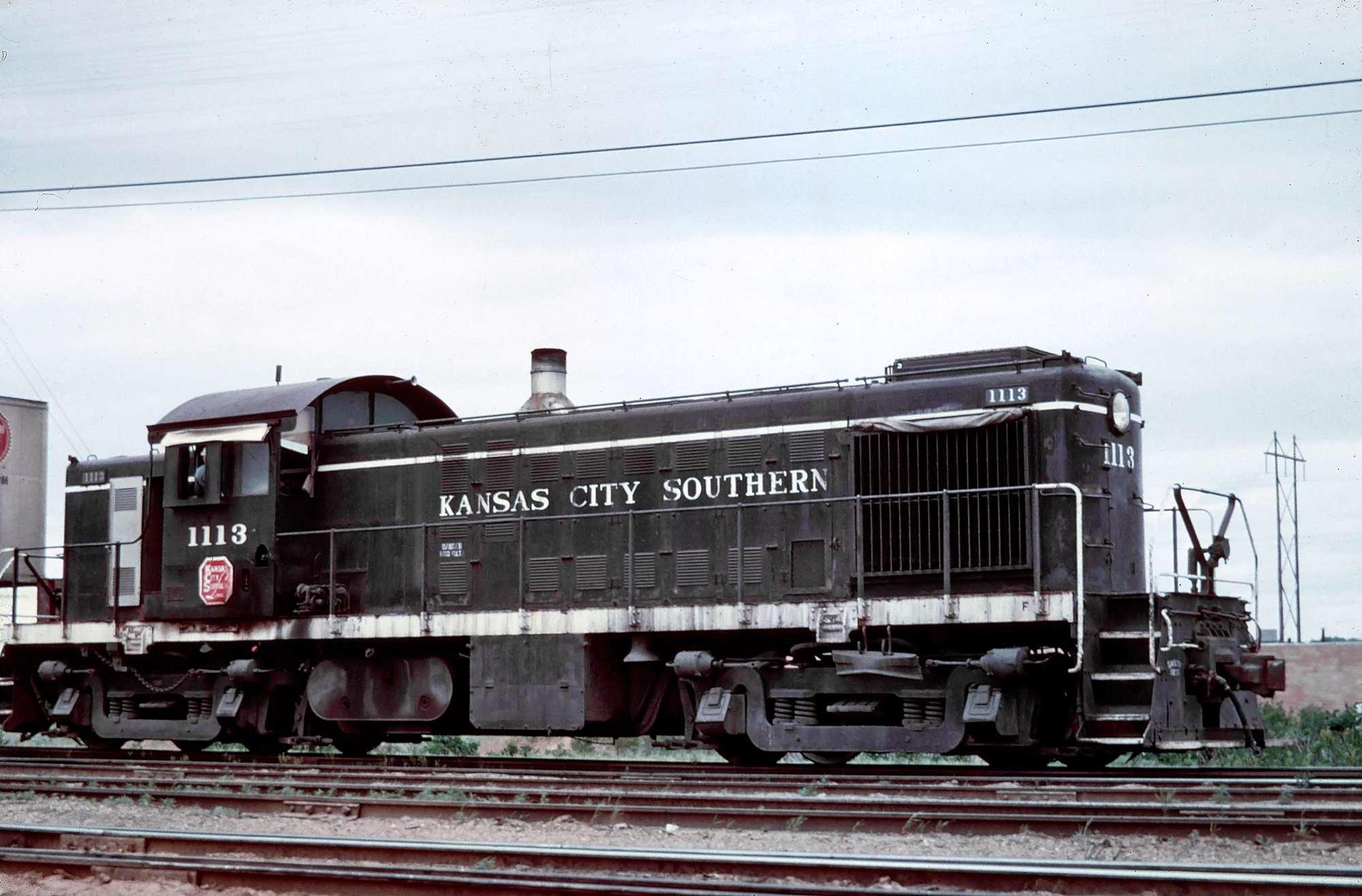 Kansas City Southern RS1 #1113 carries out switching work in Kansas City, circa 1967. American-Rails.com collection.
Kansas City Southern RS1 #1113 carries out switching work in Kansas City, circa 1967. American-Rails.com collection.Despite only modest sales numbers the RS1 could be found on railroads across the country from the Pennsylvania and New York Central to the Milwaukee Road and Northern Pacific.
While most RS1s were used in light branch line work some were also utilized in other applications, such as switching passenger cars at passenger terminals.
The later RS2 and RS3 sold thousands to several railroads and private industries, offering just the right blend of size and power. Unfortunately, later models could not replicate the same success and throughout the 1950s Alco lost ground to EMD.
Sources
- Foster, Gerald. A Field Guide To Trains. New York: Houghton Mifflin, 1996.
- Kirkland, John F. Diesel Builders, The: Volume Two, American Locomotive Company And Montreal Locomotive Works. Glendale: Interurban Press, 1989.
- Pinkepank, Jerry A. Diesel Spotter's Guide. Milwaukee: Kalmbach Publishing Company, 1967.
- Rail Heritage Publications. Early Diesel-Electric and Electric Locomotives. Simmons-Boardman Publishing Corporation, 1983.
- Schafer, Mike. Vintage Diesel Locomotives. Osceola: MBI Publishing, 1998.
- Solomon, Brian. Alco Locomotives. Minneapolis: Voyageur Press, 2009.
Contents
Recent Articles
-
Missouri's 'Wine Tasting' Train Rides
Dec 12, 25 04:13 PM
The fusion of scenic vistas, historical charm, and exquisite wines is beautifully encapsulated in Missouri's wine tasting train experiences. -
Minnesota's 'Wine Tasting' Train Rides
Dec 12, 25 04:07 PM
This article takes you on a journey through Minnesota's wine tasting trains, offering a unique perspective on this novel adventure. -
Texas - Murder Mystery - Dinner Train Rides
Dec 12, 25 01:06 PM
Here’s a comprehensive look into the world of murder mystery dinner trains in Texas.



